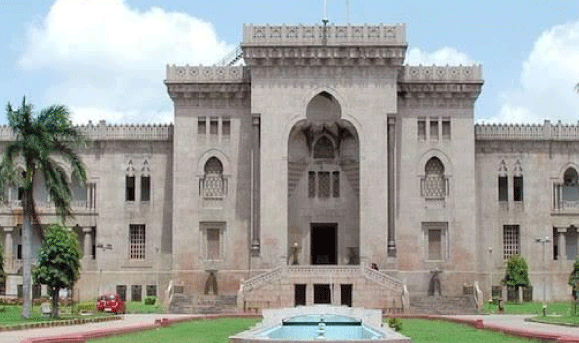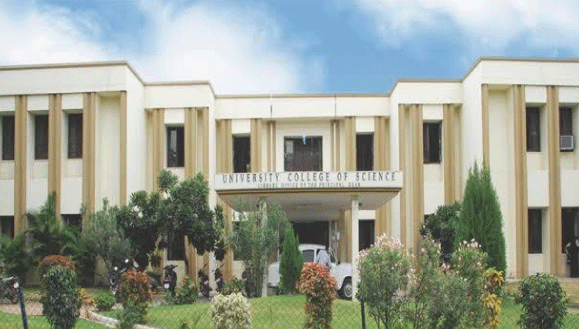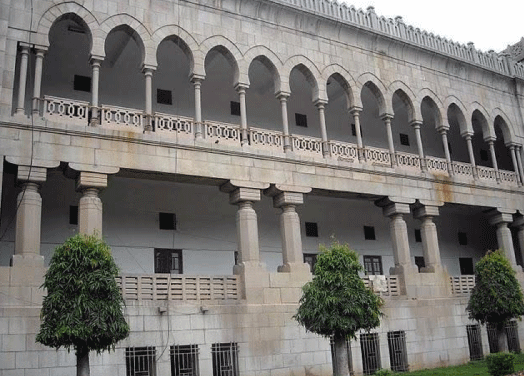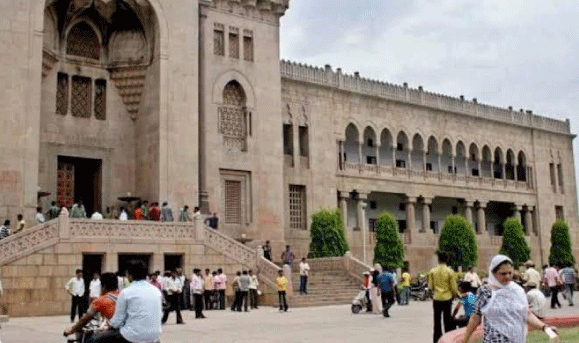Osmania UniversityOsmania University is among the oldest universities in India; it is southern India's third oldest and India's seventh oldest university. It is a public state university established in 1918 by Mir Osman Ali Khan in Hyderabad, Telangana. He was the 7th Nizam of Hyderabad, and the university is named after him. It is a collegiate university which means its functions are divided between several constituent colleges and a central administration. It is also the first university that was established in the erstwhile Kingdom of Hyderabad and the first university in India to use Urdu as the medium of instruction along with English as a compulsory subject. This University is among the largest university systems in the world. The motto of the university is 'Lead us from Darkness to Light'. 
It has more than 3,00,000 lakh students on its campus and in affiliated colleges. The famous Osmania Medical College was once part of this university, but now its supervision is under the Kaloji Narayana University of Health Sciences. The Chancellor of the university is Dr. Tamilisai Soundararajan (Governor of Telangana), and the Vice-Chancellor of the university is Prof. D Ravinder Yadav. HistoryThis University came into existence by the Farman of the last Nizam of Hyderabad, Mir Osman Ali Khan, in 1918. In British India, the need and importance for higher education were felt by every province and Princedom. The need for a university in Hyderabad was felt for a long time. Sir Akbar Hydari, Home Secretary to the State of Hyderabad, 1917, wrote a memorandum to the then Education Minister of India to establish a university with Urdu as the medium of instruction. It was widely used among the masses of the state. Sir Akbar Hydari believed that the foundation of higher education must have its foundation in the deep national consciousness. 
Though Urdu was used as a medium of instruction, English as a language subject was compulsory for every university student. The basic idea that the university wanted to achieve was an intellectual synthesis of occidental and oriental learning. Meaning the best of both West and East to be taught. It also aimed at the development of the national ethos and the creation of a social environment and academic in which National integration is kit a nebulous idea but a tangible reality. After the accession of Hyderabad in 1948, the Osmania University was administered and managed under the state government. Nizam's crown was removed from the seal of the university, and English replaced Urdu as the medium of instruction. There are four phases in which the development of the university can be divided. First Phase 1918-1947The use of vernacular language (Urdu) in all the higher education, including Engineering and Medicine, characterized the first phase. The efforts were made to establish numerous different academic departments and the structure of these academic programs. These thirty years saw the initiation of different disciplines like Civil Engineering, Chemistry, English, Physics, History, Maths, Zoology, Geography Education and Law, Agricultural Science, Medicine, etc. As the infrastructure of the university was incomplete, the offices and departments of the University were spread all over the city; it moved to its present campus in 1934. Second Phase 1948-1968This phase of the university saw two important historic events first was in 1948 when the State of Hyderabad became part of independent India, and the second important event was when English as the medium of instruction replaced Urdu. The university also celebrated its Golden Jubilee in 1968 and saw unprecedented growth in the number of students and the introduction of new disciplines like Electrical Engineering, Political Science, Public Administration, Electronic and Communication Engineering, Genetics, Statistics, Geophysics, etc. In this phase, research activity saw considerable growth, many new faculties were established, and infrastructure development was at its peak. Third Phase 1969-1993The third phase is the duration between the university's Golden Jubilee and Platinum Jubilee. Several interdisciplinary Research Centers were established with financial assistance from national and international agencies. The University established Computer Center in 1975 and the Center for Distance Education in 1977. To train and orient its university and college teachers in the areas of specialization and pedagogy, the university established the Academic Staff College in 1987. For the qualitative improvement of the academic standard of the universities, they introduced the Entrance Test for admission in postgraduate courses in 1973. Few departments of the university achieved national and international reputation during this phase. Fourth Phase 1994 OnwardsThe fourth phase of the university began in 1993 when it completed its 75 years of eventful existence and celebrated its Platinum Jubilee. This event also rededicates them to becoming the premier education center of the country and reviewing their programs and priorities. In this phase, the university introduced several community-relevant courses in the area of Biotechnology, Environmental Science, Genetic Engineering, Computer Applications, Tourism, Hotel Management, Health Technologies, and Rural Engineering. It also laid a plan to strengthen its infrastructure for the better overall progress of the University. Campus
It is the largest University in Asia, and more than 720 colleges are affiliated with it; it also has 5 constituent colleges, 8 campus colleges, and 53 university departments. The chief intellectual center of the University is its main campus in Hyderabad. Taking admission in the departments of the main campus is highly competitive. The University Colleges are established within the university's main campus, and there are total 8 such colleges:
The campus is spread over 1600 acres, and there are 3,00,000 lakh students if we count all the campuses, district centers, and constituent affiliated colleges. The architectural heritage structure of the University College of Arts & Social Sciences is similar to the College of Sultan Hassan, Cairo, Egypt. The university has all the important amenities and facilities available for its students on the campus like a hostel facility, mess and cafeteria, free medical health Center, banking facility, post office, sports ground, over 5.5 lakh books, and 5500 rare manuscripts in the library, computer center, etc. The university has 9 academic centers and 16 research centers. Courses and Admission
This university offers over 130 courses at certificate, diploma, undergraduate, postgraduate and doctoral levels in different disciplines. All these courses are offered under different faculties that total 12 in number. These faculties are Humanities, Science, Education, Management, Pharmacy, Law, Engineering, etc. Admission is done on the basis of merit in the undergraduate courses. The university also conducts CPGET (Common Postgraduate Entrance Test) for admission in postgraduate courses like M.Sc, M.A, M.Com, M.Ed, MSW, etc. It also offers different courses through distance education. The courses offered under distance education are recognized by Distance Education Bureau, New Delhi. It also accepts the scores of GATE, NET-JRF, etc., qualifying exams to get admission in various courses. It has over 500 experienced faculty members to teach and guide the students in their respective fields of study. It has also signed a number of MoUs with different Government, Private, and Defence organizations. It also has collaborative programs for the exchange of academic and research activities among students and faculty members. Ranking and AccreditationUniversity Grant Commission has recognized the Osmania University, and NAAC has accredited the university with an "A+" Grade. In the 2021 NIRF Ranking, it was ranked 32nd in the university category and 62nd in the overall category. It was ranked 144th by QS World BRICS. QS World Ranking 2022 has kept Osmania University in the rank band of 1001-1200. Osmania University has been kept in the rank band 281-290 by World Asian University. Scholarships and PlacementsThere is a variety of scholarship programs that are offered to students who want to join postgraduate courses. There are also scholarships on the basis of poverty, i.e., Economically Poor People Scholarship; other than this, there are also LBC, EBC, and SC/ST scholarships. It also has a placement cell that actively helps students of main campus and constituent colleges to fetch a job in their last semester of the course. The highest package so far was INR 14 lakh per annum. There are many different companies that visit the campus for recruitment, such as Tata Mahindra, TCS, Cognizant, Google, Amazon, HSBC, HDFC Bank, Infosys, Wipro, etc. Notable AlumniThere are many notable alumni of the university, including:
Next TopicRajasthan University
|
 For Videos Join Our Youtube Channel: Join Now
For Videos Join Our Youtube Channel: Join Now
Feedback
- Send your Feedback to [email protected]
Help Others, Please Share









